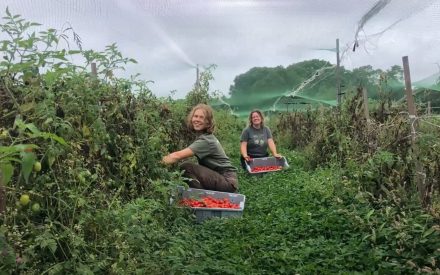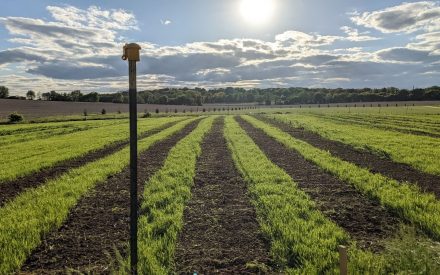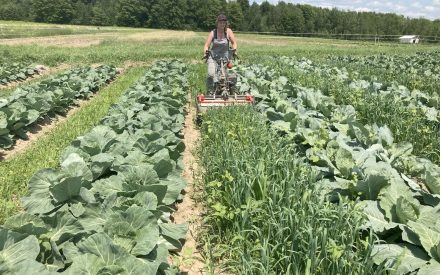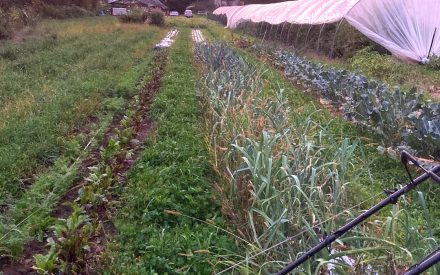Welcome to the Wisconsin Potato Back-To-Basics digital magazine. This self-paced training aid includes videos and additional linked resources aimed at walking new participants to the industry through basic production and Integrated Pest Management (IPM) options for potatoes grown in Wisconsin.
What is the potato back-to-basics magazine, and what can you learn?
This magazine, designed as a combination of written and video instructions, can be used as a primer to learn about the basics of potato production, initially focusing on Integrated Pest Management (IPM) basics. Key aspects of insect, disease, and weed IPM programs are highlighted.
Future modules, such as plant fertility, irrigation, and production (planting, harvest, and storage) management will be developed and included on an ongoing basis. The intent is to introduce these production concepts to those new to the potato industry. Each subject matter module includes a quick overview followed by several topics explored in more detail with a corresponding video with further details. Click each video individually or view in sequential order.
Video Modules
Module 1:
Potato Insect Management Basics
Module 2:
Potato Weed Management Basics
Module 3:
Potato Disease Management Basics
Module 4:
General Topics in Potato IPM
Module 1: Potato Insect Management Basics
Several insects are pests of potatoes, and some can be challenging to control. Key insect pests of potatoes in Wisconsin are Colorado potato beetles, potato leafhoppers, and green peach aphids. Proper identification, scouting, knowledge of migration, management timing and materials are all components of a comprehensive insect IPM program. Resistance management must also be considered to maintain long-term insecticide effectiveness and to avoid catastrophic yield loss.
Potato Insect Management Resources
What are some key IPM components, and why is it important to accurately identify key insect pests of potatoes in Wisconsin?
Integrated Pest Management involves using multiple tactics to achieve control at a level that reduces the risk for crop damage, and this process starts with accurate pest identification. For insects, key pests must be identified because not all insects are problems in potatoes. Identifying pests is the first step in creating accurate integrated management programs. There are apps and online resources that can help identify pests as well as diagnostic labs.
How do you scout for key insect pests and what are thresholds?
Scouting for key insects provides critical information on both the type and number of pests present. Scouting occurs in predetermined areas within a field where specific life stages and numbers of key insect pests are documented. Threshold levels, when you should take steps to limit economic damage, are used for management, but these levels vary depending on the stage of the insect. Scouting accurately among the whole field for key pests and then using specific thresholds is necessary to ensure proper management. Using new technologies for spatial management and creating maps where insect pests are more prevalent can be valuable if precision application is available and applicable.
What are insecticide modes of action, and why do they matter over the season?
Modes of action, specific active ingredients that have unique activities on the insect or life stage, must be altered and used appropriately in a resistance management program. For some insects like the Colorado potato beetle (CPB), insecticide mode of actions differ in effectiveness by pest life stage. Some insecticides are specific to adults, but others are best for eggs, early-stage instars, or later (3rd and 4th instars). Early instar larvae are usually targeted to reduce the first CPB generation in Wisconsin, with a different insecticide mode of action used for next generation management. At times, a third CBP generation can occur in Wisconsin, and if that is the case, an additional mode of action would be needed. At-plant systemic insecticides are sometimes used, but these materials should also be rotated in use to reduce the risk of resistant insects.
What are degree day models and other decision aid systems for key insect pests?
Insect development for overwintering pests can be timed based on degree-day models. Degree days are temperature-based models and can be used to predict when pests may be approaching a specific stage, may be migrating into the state, and/or may cause damage. These predictive tools help time when scouting for specific insect pests should start. To provide accurate information to growers, the University of Wisconsin has the Vegetable Disease and Insect Forecasting Network, which can model specific locations within Wisconsin to determine possible pest prevalence.
When do migratory insect pest species arrive in Wisconsin?
For pests that migrate, such as aphids and leafhoppers, the factors that drive their movement are known and should be considered in scouting and management strategies. Migratory pests usually arrive with warm winds that flow from the south, so tracking those migrations helps growers and scouts interpret patterns of insect progress. Understanding the movement of insects in general is important as well. For example, for potato leafhoppers, when alfalfa is cut, leafhoppers will travel to nearby crops and can cause damage, so if potatoes are near, scouting right after cutting would be advised.
What are the economic consequences if key insect pests are not controlled?
The key insect pests in Wisconsin potato production can cause catastrophic yield loss if left uncontrolled. Colorado potato beetles will cause complete crop canopy destruction with their direct feeding on foliage, resulting in total yield loss. Potato leafhoppers, with piercing and sucking mouthparts, can cause 20-30% yield loss while also causing tuber maturity and storability problems. Aphids can cause similar damage. Overall, each can cause damage in either the field or with storage, and the crop will not be economically viable without managing these insect pests in the field.
Is resistance to insecticides a concern?
Insects such as the Colorado potato beetle can develop a tolerance to insecticides and ultimately can become resistant to those materials. Alternating insecticide modes of action between applications, generations, years, and field locations will limit repeated exposure to the same control tools and is a key tenet of resistance management. Using non-chemical control options, such as potato rotation among years and field locations, will also delay resistance development.
One challenging new aspect to consider is the development of metabolic resistance, where insects have developed an inherited ability to overcome general stressors, including new insecticides that they may never have been exposed to. Metabolic resistance has become particularly common for insecticides that are ingested by insects where they are broken down and therefore are not effective. For these materials, multiple control tactics should be used to limit insecticide exposure.
Module 2: Potato Weed Management Basics
Weed control is essential to maintain potato yields and quality. Rotational and in-season weed management programs should be used to manage weed pests. Proper weed management programs include weed identification, integrated weed management (IPM) approaches, resistance management for herbicides, and rotational options. This section will provide an overview of weed management options for potatoes.
Potato Weed Management Resources
Why is weed control important?
Weeds can significantly reduce potato yield and quality by competing for light, water, and nutrients, increasing production costs when these resources need to be replaced. Weeds can reduce tuber quality, such as when quackgrass rhizomes grow directly into tubers, limiting marketability. Weeds can also host pest insects and plant pathogens. For example, nightshade species can host the plant pathogen that causes late blight as well as Colorado potato beetles. With these challenges in mind, holistic, season-long weed management is critical to profitable potato production.
How do you approach weed management throughout the season?
Weed control for potatoes starts in the previous crop year when weed species are scouted, properly identified, and managed. In rotational agronomic crops, management of many problematic weed species found in is more feasible because the crops are more competitive and more weed management options, such as diverse herbicides from several sites of action are available. In the potato season, weed control starts at planting. The hilling process can be used as a viable mechanical control option. Herbicides should be applied pre- and post-emergent during the season as dictated by field scouting. Desiccation and after-harvest tillage are also tools for weed management, allowing for a total season-long approach to weed management.
What are the key considerations for weed management and herbicide use in potatoes?
Growers initially must know what weeds need to be controlled, so proper identification is critical. Scouting information from previous years and long-term field data can be used to know which species are in the field. Soil type, variety, and sensitivity to various herbicides should be researched before deciding on herbicide options. Preharvest intervals must be reviewed to ensure there is enough time from application prior to harvest to limit residual concerns based on label requirements. Similarly, review rotational restrictions between the potato and future crops because some residual herbicides may carry over into the next cropping season. Remember, herbicides differ in persistence (how long they last and are effective) and environmental degradation (how long they remain in soil), so proper application methods must be followed to ensure good weed control while protecting the nearby environment.
How can we manage herbicide effectiveness over the rotation?
Herbicides are the primary method to control weeds in conventional potato production, but resistant weeds can limit control effectiveness. Target site resistance occurs when weeds have altered enzymatic binding sites and the herbicide no longer blocks plant growth processes, resulting in a weed that continues to grow, reproduce, and pass the resistant trait on to the next generation. A more recent form of resistance is called metabolic resistance, which is where plants have metabolic enzymes to detoxify stressors such as herbicides, negating their effectiveness. Overall, rotating herbicide sites of action and proper use and timing of materials will help limit resistance development.
Which weeds have been found with metabolic resistance?
In Wisconsin, tall waterhemp (related to common pigweed species) is known for having metabolic resistance and is very difficult to control. In areas of the Midwest, certain waterhemp species are resistant to herbicides even during their first herbicide application, making waterhemp very difficult to control. If you have concerns about resistance development, review management options and learn how to determine if a weed is resistant or if the control failure is related to other factors, such as application and weather conditions.
Module 3: Potato Disease Management Basics
For a comprehensive potato disease management program, there must be an understanding of the principles of the disease triangle, incorporating prediction methods, and using cultural and fungicide options when necessary to ensure the overall health and productivity of the crop.
Traditionally, fungicides are used to prevent diseases, but additional components and tools should be considered along with fungicide use. This section explores many of the basic needs and additional tools for potato disease management, including understanding disease timing and development, weather forecasting systems, prediction tools, scouting options, and other tactics.
Potato Disease Management Resources
What are key disease concerns and management options for potatoes in Wisconsin?
Plant diseases can significantly reduce potato yield and quality. Diseases can be annual or sporadic, but it is important to remember that diseases can only occur when there is a susceptible host, a virulent pathogen, and a conducive environment, known as the disease triangle. Multiple tactics can help limit disease development, including host resistance, pathogen exclusion, and non-favorable environmental conditions limiting disease impacts.
One key disease in Wisconsin is potato early blight. All potato varieties are susceptible to early blight, and in Wisconsin, the weather accommodates early blight onset, reducing crop photosynthesis and, subsequently, tube production. Integrated potato disease management strategies for early blight include planting tolerant varieties when applicable, emphasizing control tactics in rotational crops, providing good weed management, and maintaining proper fertility and irrigation to ensure plant health. Appropriate disease management and multiple control strategies can be used to protect the vines at their most vulnerable stages.
When and how do you time fungicides for disease control in potatoes?
Fungicides are used as needed for disease management and to maintain potato plant health. Disease forecasting tools can be used to determine when fungicide use should be initiated. Wisconsin has a robust disease modeling program and has both P-Day (physiological days) and Severity Value calculators that estimate timing for first fungicide applications. These values can be found by looking at data from weather stations around the state or on your own farm and can be used to effectively time applications based on weather data.
For early blight, this forecasting tool predicts when 300 P-days are accumulated, signifying the need to start fungicide applications that are then continued on a regular basis to maintain plant protection. Commonly, broad-spectrum fungicides are used since they will suppress multiple diseases found in potatoes. A comprehensive disease management program will reduce crop yield and quality risks, protect nearby crop fields, and reduce the risk for resistance development.
What are the types of fungicides?
Multiple types of fungicides, including preventative, curative, and seed-applied treatments are discussed. Protectants are applied before the onset of disease and are the most effective at protecting plants initially from infections. Curative products may be able to stop or “cure” infections if onset was within a day or two, but longer-term curative fungicide options are rare and therefore need to be used within an overall fungicide management program, which includes the use of both protective and curative materials.
Some of these are broad-spectrum fungicide products, meaning they can control multiple disease pests, while others are single-site or specialty products with specific modes of action and would be designed to control only a certain disease pathogen. Seed-applied materials can be used for certain diseases that are prevalent in Wisconsin, and these are applied during seed cutting to limit seed-borne diseases. Fungicides can also be applied in-furrow at planting to target pathogens in soil or on potato seed tubers. In field applications will usually start around row-closure, based on P-day accumulations, and continue as discussed earlier. Overall, using all fungicide types in a comprehensive disease management program is most effective and reduces the risk for resistance development.
What are FRAC codes, and how do they help manage resistance?
Fungicide resistance management is aided by the Fungicide Resistance Action Committee (FRAC) codes, a numbering system to describe different biological categories (modes of action) that fungicides act on. Some pathogens are resistant to specific FRAC codes, so these fungicides must be used judiciously and appropriately to delay or avoid resistance. Consideration of FRAC codes can help develop proper fungicide rotations and designate materials with a higher risk of the onset of resistance development to be used only when needed.
How are potatoes scouted for plant diseases?
Potato scouting can accurately identify disease development and determine if there are any “hot spots” for disease occurring in the field. Scouts usually travel along field paths made by irrigation equipment, but scouts walk so they can analyze all areas of the field, including by edges of tree lines where applications may not be as effective and therefore, disease may be more prevalent. Also, scouts should know where potato diseases are found on the plant and their key identification characteristics to make accurate diagnoses.
What are some late-blight-specific concerns and requirements?
Late blight is an industry-wide disease problem in potatoes that cannot be allowed to spread but can be managed if proper steps are taken. Potato late blight disease management is required by Wisconsin laws. For example, cull piles must be removed and handled appropriately because they are a source of late blight inoculum. Late blight spores can move up to 40 miles; therefore, inoculum sources need to be eliminated. If late blight is found in a field, it must be managed by crop destruction or through the use of specific fungicides. Blitecast is a tool used to determine risk values for the timing of first fungicide applications for late blight, as it counts disease severity values (DSV) based on weather conditions. When 18 DSVs are accumulated, fungicides should be applied to limit late blight onset.
Module 4: General Topics in Potato Integrated Pest Management
A comprehensive understanding of potato IPM can be useful in the context of overall production considerations. This section describes some general topics related to potato IPM and contains details on how IPM can be used for marketing, promotions, and how new data and technologies may be used in the near future. Finally, a discussion of general resistance management as it relates to management action coding designations and requirements is had.
General Topics in Potato IPM Resources
Why do I need to be concerned with IPM overall?
Overall, integrated pest management (IPM) isn’t just for croplands, as IPM programs are found in schools, homes, public health, and other locations. Overall, IPM uses a variety of tools to combat pests, and while not new, it has evolved over time from simple scouting and treatment thresholds to a more holistic and system-wide approach. IPM now includes seasonal, rotational, and ecological approaches, which include adjacent landscapes and multiple species consideration. More importantly, IPM is now needed for most crop certification and marketplace programs that are looking for documentation to show advancements on farms. Finally, IPM provides a positive view for public relations and promotions within farming systems.
What can I do with data and new technologies?
Data is important when we discuss IPM, as we know that scouting, pesticide, nutrient and production management, water use, and other farm data are needed and should be kept to direct decision making for current and future years. But other, newer technologies and datasets, such as using GPS locations for mapping and long-term management, are also vital. Growers are now looking at new forms of technology and incorporating data into their decisions, such as using laser weeders—which use artificial intelligence (AI) for management, sensing for insect populations, remote sensing for monitoring of cropping systems—and drones for applications and monitoring. Overall, data can be used for longer-term management and can enhance and finesse current management systems.
Why is resistance management important?
Resistance is the ability of pests to genetically overcome the effectiveness of pesticides, negating the use of those materials. Resistance management includes strategies to maintain pesticide effectiveness and to limit resistance development when existing or newer, reduced-risk materials come onto the market. Insecticide (IRAC), herbicide (HRAC), and fungicide (FRAC) resistance action committees delineate pesticides by mode/site of action codes and make recommendations for resistance management programs. Furthermore, pesticide labels include resistance action codes and specific steps that need to be followed to reduce the risk of selecting resistant pests. Overall, using some of the general strategies, such as alternating materials, limiting applications to when needed, and not using ultra-low rates, should help keep materials viable for a longer time while maintaining pest control effectiveness.
Print Potato Back to Basics Magazine
The PDF available on this page is intended for download, local use, and print.
Updated: Dec. 2025

 Living Aisles Case Study #1: Sawyer Farm, Worthington, MA & Momentum Ag
Living Aisles Case Study #1: Sawyer Farm, Worthington, MA & Momentum Ag Living Aisles Case Study #2: Gorman Farm, Fitchburg, WI
Living Aisles Case Study #2: Gorman Farm, Fitchburg, WI Living Aisles Case Study #3: Red Door Family Farm, Athens, WI
Living Aisles Case Study #3: Red Door Family Farm, Athens, WI Living Aisles Case Study #4: Circadian Organics, Ferryville, WI
Living Aisles Case Study #4: Circadian Organics, Ferryville, WI


